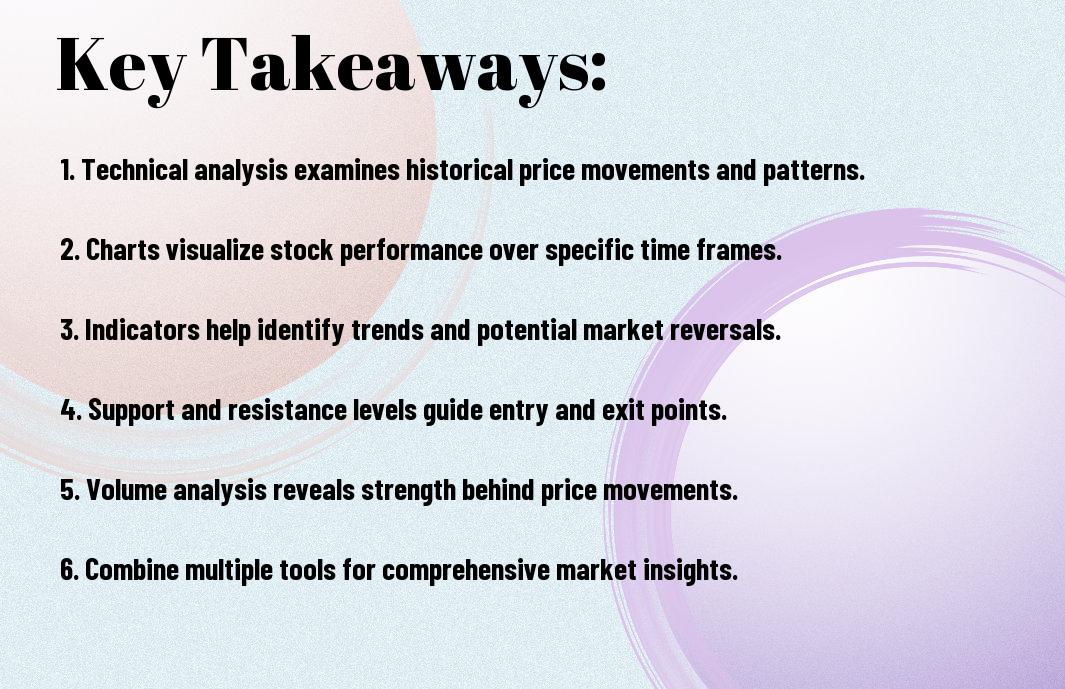Most investors encounter technical analysis as a powerful tool for making informed trading decisions. By examining price movements and trading volumes, you can identify patterns and trends that help predict future market behavior. This blog post will guide you through the foundational concepts of technical analysis, including key indicators and charting techniques, enabling you to enhance your trading strategy and improve your market timing. Whether you’re a beginner or looking to sharpen your skills, understanding these basics will empower you to navigate the complex world of stock trading more effectively.
Key Takeaways:
- Price Trends: Understanding the direction of price movements—whether they are trending up, down, or sideways—is imperative for making informed trading decisions.
- Support and Resistance: Identifying key levels where the stock tends to find buying (support) or selling (resistance) pressure can help traders predict potential price reversals.
- Volume Analysis: Analyzing trading volume provides insights into the strength of a price movement, helping traders assess whether a trend is likely to continue or reverse.

Understanding Technical Analysis
The realm of technical analysis serves as a vital tool for traders looking to make informed decisions in the stock market. By examining historical price movements and trading volumes, you can gain insights into potential future price trends. This approach emphasizes the importance of charts and indicators, enabling you to identify patterns that could indicate buying or selling opportunities.
Definition and Importance
Technical analysis refers to the method of evaluating stocks based on historical price data and market activity. It allows you to assess market sentiment and predict future price movements, making it an imperative component of your trading strategy.
Key Principles of Technical Analysis
On your journey to mastering technical analysis, it’s imperative to understand its key principles, which include the belief that historical price trends tend to repeat themselves and that all available information is already reflected in the stock’s price. By adopting this perspective, you can better anticipate market movements.
Another important principle is the use of various chart patterns and technical indicators, such as moving averages and relative strength index (RSI). These tools help you identify whether an asset is overbought or oversold, guiding your trading decisions. Combining these principles can ultimately empower you to make more informed trades based on market behavior rather than emotions.
Chart Types and Patterns
If you want to excel in stock trading, understanding chart types and patterns is imperative. Various charts provide insights into market movements, helping you make informed decisions. Here are some common properties:
| Property | Description |
|---|---|
| Time Frame | Duration over which price movements are analyzed. |
| Price Action | Visual representation of price changes over time. |
| Scalability | Ability to zoom in/out for details or long-term trends. |
| Indicators | Overlay tools that help predict price movements. |
| Volume | Shows the number of shares traded, reflecting market interest. |
After gaining a solid grasp of these aspects, you will be better prepared to analyze and trade effectively.
Common Chart Types
Between line, bar, and candlestick charts, each type offers unique insights. Understanding these can enhance your analysis:
| Chart Type | Features |
|---|---|
| Line Chart | Displays closing prices over time as a single line. |
| Bar Chart | Shows opening, closing, high, and low prices for a time period. |
| Candlestick Chart | Visualizes price movement with color coding for trends. |
| Point and Figure Chart | Focuses on price changes without time consideration. |
| Renko Chart | Ignores time and uses bricks for price movements. |
Knowing these chart types will help you choose the best one for your trading strategy.
Recognizing Chart Patterns
Below are key patterns that can signify potential market trends. Being able to identify these will help you anticipate price movements:
Chart patterns, such as head and shoulders or triangles, often indicate reversals or continuations in the market trend. By learning to recognize these formations, you will better position yourself in trades. Pay attention to volume and other indicators to confirm pattern validity. This combination of factors can guide your trading strategy, providing a clearer path to success. Familiarity with chart patterns enables you to anticipate potential price movements and make informed decisions in your trading process.
Technical Indicators
Your understanding of technical indicators is imperative for successful stock trading. These tools facilitate the analysis of price movements and market trends, helping you make informed buying and selling decisions. By applying various indicators, you can enhance your trading strategies and improve your overall investment performance.
Types of Technical Indicators
Your toolkit for technical analysis includes several types of indicators. Each serves a unique purpose in guiding your trading decisions:
- Trend Indicators
- Momentum Indicators
- Volume Indicators
- Volatility Indicators
- Market Strength Indicators
This variety enables you to analyze different market conditions effectively.
| Indicator Type | Description |
| Trend Indicators | Gauge the direction of price movements over time. |
| Momentum Indicators | Show the speed of price changes. |
| Volume Indicators | Indicate the number of shares traded in a specified period. |
| Volatility Indicators | Measure price fluctuations over time. |
| Market Strength Indicators | Assess the relative strength of a market move. |
How to Use Indicators Effectively
Any effective use of indicators requires a clear understanding of their signals and the ability to interpret them accurately. Combine multiple indicators to gain deeper insights, as relying on a single metric can lead to misleading conclusions. By developing a consistent analytical approach, you.
And by applying various indicators together, you can identify trading opportunities more confidently. For instance, using trend indicators alongside momentum indicators can confirm the strength of a price movement. Always consider market context and personal risk tolerance to ensure your trading decisions align with your financial goals.

The Role of Volume in Trading
Keep in mind that volume is a vital indicator in trading, as it shows the number of shares traded during a specific time frame. Analyzing volume can provide insights into the strength or weakness of a market trend, helping you make informed decisions on when to enter or exit trades. High volume often signals strong interest in a price movement, while low volume may indicate a lack of conviction. Thus, understanding volume is instrumental in enhancing your trading strategy.
Understanding Volume
To grasp the significance of volume, consider it as the backbone of price movements in stock trading. It reflects the intensity of buying and selling activity, allowing you to assess whether trends are supported by strong market participation. When volume increases alongside price changes, it often reinforces the validity of the trend, whereas price changes with low volume may suggest a potential reversal.
Volume Analysis Techniques
Below are several techniques for analyzing volume effectively. You can use indicators such as the On-Balance Volume (OBV) and the Chaikin Money Flow (CMF) to assess buying and selling pressure in relation to price movements. Additionally, you might consider volume spikes, which typically signal strong investor interest and can indicate potential trend changes. Remember to analyze volume in conjunction with price action to enhance the validity of your trading signals.
Volume can provide valuable context to your trading strategy. By monitoring how volume interacts with price, you gain a deeper insight into market sentiment. For instance, if a stock price is rising sharply but the volume remains low, it may suggest a weaker trend that is not supported by strong buying interest. Conversely, if both price and volume are increasing, this could indicate a healthy uptrend. Incorporating these volume analysis techniques into your daily trading routine can significantly improve your decision-making process.
Analyzing Market Trends
Once again, understanding market trends is imperative for successful trading, as they can indicate potential future price movements. By analyzing trends, you can make informed decisions about when to enter or exit trades. Trend analysis not only helps you identify bullish or bearish conditions but also enables you to align your strategies with the overall market sentiment, enhancing your potential for profit.
Identifying Trends
Along with basic price movements, recognizing trends begins with observing price patterns over time. Consider the direction of the market: is it moving upward, downward, or sideways? Utilizing tools like trendlines and moving averages can assist you in pinpointing these directions, allowing for better predictions and trade placements in line with prevailing market conditions.
Trend Reversal Signs
Any trader needs to be vigilant for signals that indicate a potential trend reversal, as these can provide lucrative opportunities for entry or exit. Common signs include candlestick patterns, divergence in indicators, or sudden shifts in volume, which may suggest that the prevailing trend is losing momentum and a change is imminent.
It’s important to approach trend reversal signs with caution, as they can sometimes lead to false signals. Look for a confluence of indicators to validate a trend reversal before making your trading decision. Utilizing chart patterns like head and shoulders or double tops/bottoms can further enhance your ability to identify significant shifts in market sentiment, allowing you to react appropriately to potential changes in trend direction.
Risk Management in Technical Analysis
Unlike fundamental analysis, technical analysis requires you to implement robust risk management strategies to protect your investments. Understanding how to mitigate risks can enhance your trading performance. You can learn more about these strategies by checking out Investing Basics: Technical Analysis.
Setting Stop-loss Orders
With stop-loss orders, you establish a predetermined exit point for your trades, limiting your losses and guarding your capital. This strategy involves setting a price level at which your position will automatically close if the market moves against you, allowing you to manage risk effectively.
Position Sizing Strategies
Across trading strategies, position sizing is integral to managing your overall risk exposure. Determining how much of your capital to allocate to each trade is important in minimizing potential losses while maximizing gains.
For instance, you may decide to risk only a small percentage of your trading capital on a single position. This practice allows you to withstand multiple consecutive losses without significantly affecting your overall portfolio. Additionally, adjusting your position size based on the volatility of the asset can help ensure that your risk remains consistent across trades, keeping your capital protected while you navigate the markets.
Summing Up
As a reminder, mastering the basics of technical analysis in stock trading can significantly enhance your decision-making skills. By interpreting price movements and using various indicators, you can better assess market trends and make informed trades. To deepen your understanding and learn how to perform technical analysis, consider utilizing online resources that offer in-depth insights and practical strategies. Embrace these techniques to potentially improve your trading outcomes and build your confidence in the market.
FAQ
Q: What is technical analysis and how is it used in stock trading?
A: Technical analysis is a method used to evaluate securities by analyzing statistics generated by market activity, such as past prices and volume. Traders utilize charts and other tools to identify patterns and trends, which can assist in making informed decisions about buying or selling stocks. Unlike fundamental analysis, which focuses on a company’s financial health and performance metrics, technical analysis is more about market sentiment and price movements.
Q: What are the common indicators used in technical analysis?
A: There are several key indicators that traders often use in technical analysis. Some of the most common include moving averages, which help smooth out price data to identify trends; Relative Strength Index (RSI), which measures the speed and change of price movements; and Bollinger Bands, which indicate volatility and potential overbought or oversold conditions. These indicators can help traders make predictions about future price movements based on past patterns.
Q: How can I start using technical analysis in my trading strategy?
A: To begin incorporating technical analysis into your trading strategy, start by familiarizing yourself with various chart patterns and indicators. You can access charting software or trading platforms that offer these tools. Begin practice by analyzing historical data to recognize patterns, and gradually apply this knowledge to live trades. It’s also beneficial to create a trading plan that incorporates risk management and clearly defines your entry and exit points based on your technical analysis observations.

